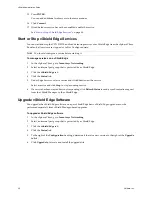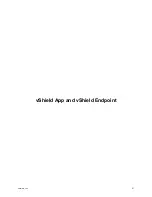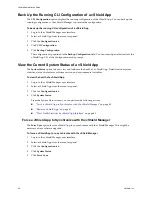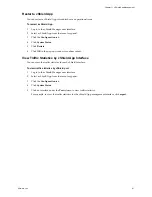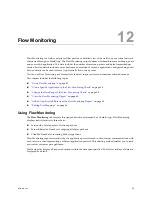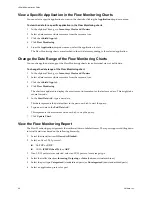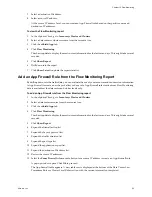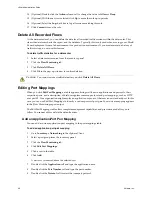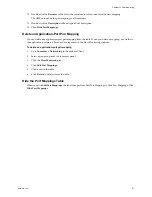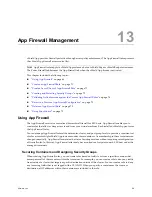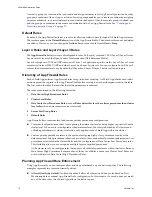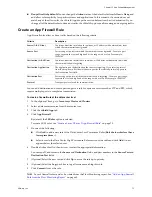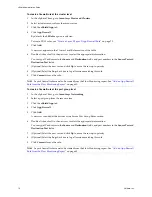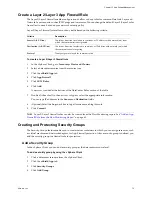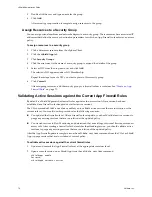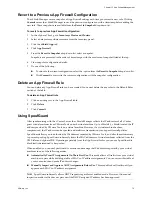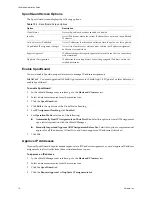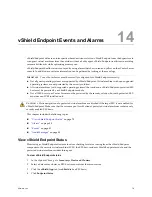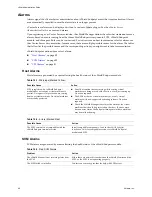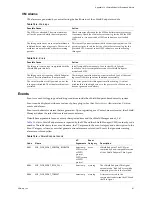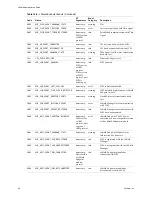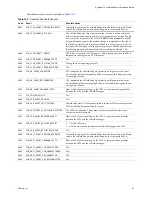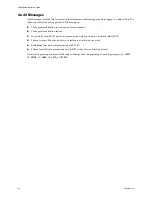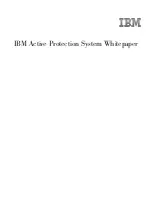
vShield Administration Guide
70
VMware, Inc.
A security group is a trust zone that you create and assign resources to for App Firewall protection. Security
groups are containers, like a vApp or a cluster. Security groups enables you to create a container by assigning
resources arbitrarily, such as virtual machines and network adapters. After the security group is defined, you
add the group as a container in the source or destination field of an App Firewall rule. See
“Creating and
Protecting Security Groups”
on page 73.
Default Rules
By default, the App Firewall enforces a set of rules allowing traffic to pass through all vShield App instances.
These rules appear in the
Default Rules
section of the App Firewall table. The default rules cannot be deleted
or added to. However, you can change the
Action
element of each rule from
Allow
to
Deny
.
Layer 4 Rules and Layer 2/Layer 3 Rules
The
App Firewall
tab offers two sets of configurable rules: L4 (Layer 4) rules and L2/L3 (Layer 2/Layer 3) rules.
Layers refer to layers of the Open Systems Interconnection (OSI) Reference Model.
Layer 4 rules govern TCP and UDP transport of Layer 7, or application-specific, traffic. Layer 2/Layer 3 rules
monitor traffic from ICMP, ARP, and other Layer 2 and Layer 3 protocols. You can configure Layer 2/Layer 3
rules at the datacenter level only. By default, all Layer4 and Layer 2/Layer 3 traffic is allowed to pass.
Hierarchy of App Firewall Rules
Each vShield App enforces App Firewall rules in top-to-bottom ordering. A vShield App checks each traffic
session against the top rule in the App Firewall table before moving down the subsequent rules in the table.
The first rule in the table that matches the traffic parameters is enforced.
The rules are enforced in the following hierarchy:
1
Data Center High Precedence Rules
2
Cluster Level Rules
3
Data Center Low Precedence Rules
(seen as
Rules below this level have lower precedence than cluster
level rules
when a datacenter resource
is selected)
4
Secure Port Group Rules
5
Default Rules
App Firewall offers container-level and custom priority precedence configurations:
Container-level precedence refers to recognizing the datacenter level as being higher in priority than the
cluster level. When a rule is configured at the datacenter level, the rule is inherited by all clusters and
vShield agents therein. A cluster-level rule is only applied to the vShield App within the cluster.
Custom priority precedence refers to the option of assigning high or low precedence to rules at the
datacenter level. High precedence rules work as noted in the container-level precedence description. Low
precedence rules include the Default Rules and the configuration of Data Center Low Precedence rules.
This flexibility allows you to recognize multiple layers of applied precedence.
At the cluster level, you configure rules that apply to all vShield App instances within the cluster. Because
Data Center High Precedence Rules are above Cluster Level Rules, ensure your Cluster Level Rules are
not in conflict with Data Center High Precedence Rules.
Planning App Firewall Rule Enforcement
Using App Firewall, you can configure allow and deny rules based on your network policy. The following
examples represent two common firewall policies:
Allow all traffic by default.
You keep the default allow all rules and add deny rules based on Flow
Monitoring data or manual App Firewall rule configuration. In this scenario, if a session does not match
any of the deny rules, the vShield App allows the traffic to pass.
Содержание VSHIELD APP 1.0.0 UPDATE 1 - API
Страница 9: ...VMware Inc 9 vShield Manager and vShield Zones...
Страница 10: ...vShield Administration Guide 10 VMware Inc...
Страница 14: ...vShield Administration Guide 14 VMware Inc...
Страница 18: ...vShield Administration Guide 18 VMware Inc...
Страница 24: ...vShield Administration Guide 24 VMware Inc...
Страница 34: ...vShield Administration Guide 34 VMware Inc...
Страница 42: ...vShield Administration Guide 42 VMware Inc...
Страница 46: ...vShield Administration Guide 46 VMware Inc...
Страница 47: ...VMware Inc 47 vShield Edge and Port Group Isolation...
Страница 48: ...vShield Administration Guide 48 VMware Inc...
Страница 57: ...VMware Inc 57 vShield App and vShield Endpoint...
Страница 58: ...vShield Administration Guide 58 VMware Inc...
Страница 62: ...vShield Administration Guide 62 VMware Inc...
Страница 68: ...vShield Administration Guide 68 VMware Inc...
Страница 78: ...vShield Administration Guide 78 VMware Inc...
Страница 85: ...VMware Inc 85 Appendixes...
Страница 86: ...vShield Administration Guide 86 VMware Inc...
Страница 130: ...vShield Administration Guide 130 VMware Inc...
Страница 144: ...vShield Administration Guide 144 VMware Inc...

